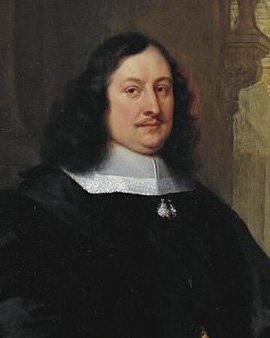The Flemish baroque painter David Teniers (1610 - 1690) was an extremely versatile artist who tried his hand at almost every possible genre. He modernized many genres such as still life, history, landscape and portrait painting. Since his father David Teniers was also a well-known painter, he is often referred to as David Teniers the Younger. His father was also his first teacher and thus significantly influenced his work. At the age of 16 he began his apprenticeship with him. Together they worked on their father's projects. Teniers the Elder often had financial difficulties and therefore had to go to prison several times. David Teniers the younger had to support the family financially during this time by making and selling copies of old masters.
Other important personalities in David Tenier's education and influencers on his later style were his compatriots Peter Paul Rubens and Adriaen Brouwer. In 1637 he finally married Ruben's foster daughter Anna Brueghel. Her biological, deceased father was the famous painter Jan Brueghel der Ältere. With this marriage, Teniers not only strengthened his relationship with Rubens, who was best man at the marriage, but also secured a place for himself in the elite circles of the art scene. For although many of Tenier's works depicted the common people, such as farmers, soldiers or drinking room scenes, he himself felt drawn to higher society and the nobility. Although he never received a title of nobility, he was able to rise to the position of court painter in Brussels in 1651.
As court painter he was also the curator of the comprehensive art collection of Archduke Leopold Wilhelm. During this time he produced the "Theatrum pictorium", the first illustrated catalogue of a collection of paintings. Teniers was an extremely productive artist. He is said to have created a total of about 2000 works of art, many hundreds of which are still preserved today. Of these, around 800 depict barmen, alchemists or rural scenes, such as "Peasant Wedding", "The Alchemist" or "Smokers in the Inn". In addition to these genre paintings, a large part of his pictures, about 200 motifs, deals with "The Temptations of Saint Anthony". Along with Peter Paul Rubens, Anthonius van Dyck and Jacob Jordaens, Teniers the Younger is considered one of the most important Flemish painters of the 17th century.
×





jpg - (MeisterDrucke-7768).jpg)
jpg - (MeisterDrucke-7768).jpg)
_Oil_on_canvas_-_(MeisterDrucke-945990).jpg)
_Oil_on_canvas_-_(MeisterDrucke-945990).jpg)
.jpg)
.jpg)
.jpg)
.jpg)
.jpg)
.jpg)
.jpg)
.jpg)
.jpg)
.jpg)
 - (MeisterDrucke-70275).jpg)
 - (MeisterDrucke-70275).jpg)
.jpg)
.jpg)
.jpg)
.jpg)
.jpg)
.jpg)
.jpg)
.jpg)
.jpg)
.jpg)
.jpg)
.jpg)
.jpg)
.jpg)
.jpg)
.jpg)
.jpg)
.jpg)
.jpg)
.jpg)
.jpg)
.jpg)
.jpg)
.jpg)
.jpg)
.jpg)
.jpg)
.jpg)
_17th_cent_-_(MeisterDrucke-951757).jpg)
_17th_cent_-_(MeisterDrucke-951757).jpg)
.jpg)
.jpg)
.jpg)
.jpg)
.jpg)
.jpg)
 - (MeisterDrucke-98444).jpg)
 - (MeisterDrucke-98444).jpg)
_in_his_art_gallery_in_Brussels_-_(MeisterDrucke-1565523).jpg)
_in_his_art_gallery_in_Brussels_-_(MeisterDrucke-1565523).jpg)
.jpg)
.jpg)
 - (MeisterDrucke-228240).jpg)
 - (MeisterDrucke-228240).jpg)
.jpg)
.jpg)
.jpg)
.jpg)
_-_(MeisterDrucke-320895).jpg)
_-_(MeisterDrucke-320895).jpg)
.jpg)
.jpg)
.jpg)
.jpg)
.jpg)
.jpg)
.jpg)
.jpg)
.jpg)
.jpg)
.jpg)
.jpg)
.jpg)
.jpg)
.jpg)
.jpg)
_16_-_(MeisterDrucke-970342).jpg)
_16_-_(MeisterDrucke-970342).jpg)
 - (MeisterDrucke-39031).jpg)
 - (MeisterDrucke-39031).jpg)
.jpg)
.jpg)
 - (MeisterDrucke-103393).jpg)
 - (MeisterDrucke-103393).jpg)
.jpg)
.jpg)
 - (MeisterDrucke-66971).jpg)
 - (MeisterDrucke-66971).jpg)
_Ec_Fl_-_(MeisterDrucke-985587).jpg)
_Ec_Fl_-_(MeisterDrucke-985587).jpg)
.jpg)
.jpg)
.jpg)
.jpg)
.jpg)
.jpg)
.jpg)
.jpg)
 - (MeisterDrucke-48037).jpg)
 - (MeisterDrucke-48037).jpg)
.jpg)
.jpg)
.jpg)
.jpg)
.jpg)
.jpg)
_in_his_Picture_Gallery_in_Brussels_-_(MeisterDrucke-899918).jpg)
_in_his_Picture_Gallery_in_Brussels_-_(MeisterDrucke-899918).jpg)
 in his Picture Gallery c1647 (oil on copper) - (MeisterDrucke-92411).jpg)
 in his Picture Gallery c1647 (oil on copper) - (MeisterDrucke-92411).jpg)
.jpg)
.jpg)
.jpg)
.jpg)
.jpg)
.jpg)
_-_(MeisterDrucke-1041862).jpg)
_-_(MeisterDrucke-1041862).jpg)
_-_(MeisterDrucke-970437).jpg)
_-_(MeisterDrucke-970437).jpg)
.jpg)
.jpg)
.jpg)
.jpg)
.jpg)
.jpg)
.jpg)
.jpg)
_-_(MeisterDrucke-898504).jpg)
_-_(MeisterDrucke-898504).jpg)
.jpg)
.jpg)
 - (MeisterDrucke-215718).jpg)
 - (MeisterDrucke-215718).jpg)
.jpg)
.jpg)
.jpg)
.jpg)
.jpg)
.jpg)
.jpg)
.jpg)
 - (MeisterDrucke-100910).jpg)
 - (MeisterDrucke-100910).jpg)
.jpg)
.jpg)
_Oil_on_wood_size_-_(MeisterDrucke-1317831).jpg)
_Oil_on_wood_size_-_(MeisterDrucke-1317831).jpg)
.jpg)
.jpg)
 - (MeisterDrucke-127909).jpg)
 - (MeisterDrucke-127909).jpg)
.jpg)
.jpg)
.jpg)
.jpg)
.jpg)
.jpg)
_Ec_Fl_-_(MeisterDrucke-950727).jpg)
_Ec_Fl_-_(MeisterDrucke-950727).jpg)
_-_(MeisterDrucke-181516).jpg)
_-_(MeisterDrucke-181516).jpg)
_Peinture_de_David_Teniers_le_jeune_(1610-169_-_(MeisterDrucke-1313855).jpg)
_Peinture_de_David_Teniers_le_jeune_(1610-169_-_(MeisterDrucke-1313855).jpg)
_17th_centu_-_(MeisterDrucke-1002552).jpg)
_17th_centu_-_(MeisterDrucke-1002552).jpg)
_-_(MeisterDrucke-546045).jpg)
_-_(MeisterDrucke-546045).jpg)
_-_(MeisterDrucke-961479).jpg)
_-_(MeisterDrucke-961479).jpg)
_-_(MeisterDrucke-1457619).jpg)
_-_(MeisterDrucke-1457619).jpg)
.jpg)
.jpg)
.jpg)
.jpg)
_Peinture_de_David_Teniers_le_jeune_(1610-169_-_(MeisterDrucke-1325511).jpg)
_Peinture_de_David_Teniers_le_jeune_(1610-169_-_(MeisterDrucke-1325511).jpg)
_Sketches_of_Women_Bending_Ov_-_(MeisterDrucke-1617730).jpg)
_Sketches_of_Women_Bending_Ov_-_(MeisterDrucke-1617730).jpg)
.jpg)
.jpg)
.jpg)
.jpg)
.jpg)
.jpg)
.jpg)
.jpg)
 1747 - (MeisterDrucke-98839).jpg)
 1747 - (MeisterDrucke-98839).jpg)
.jpg)
.jpg)
.jpg)
.jpg)






